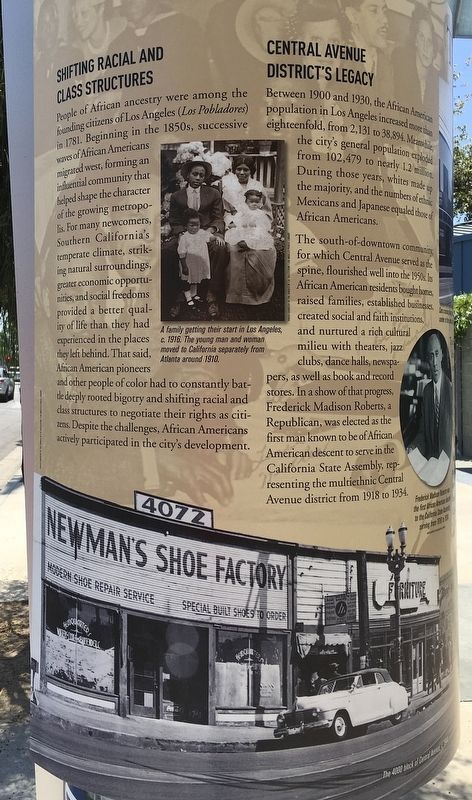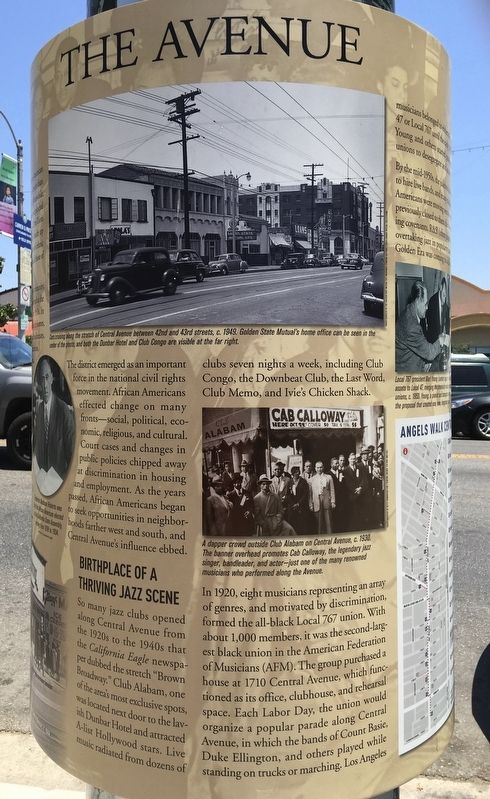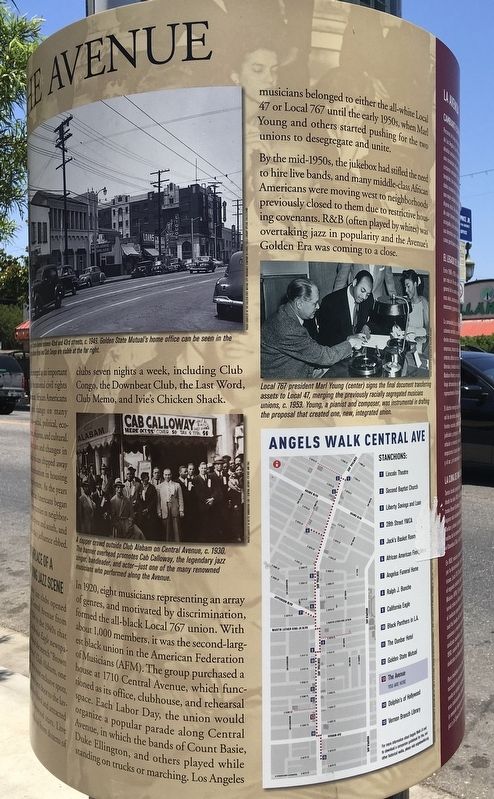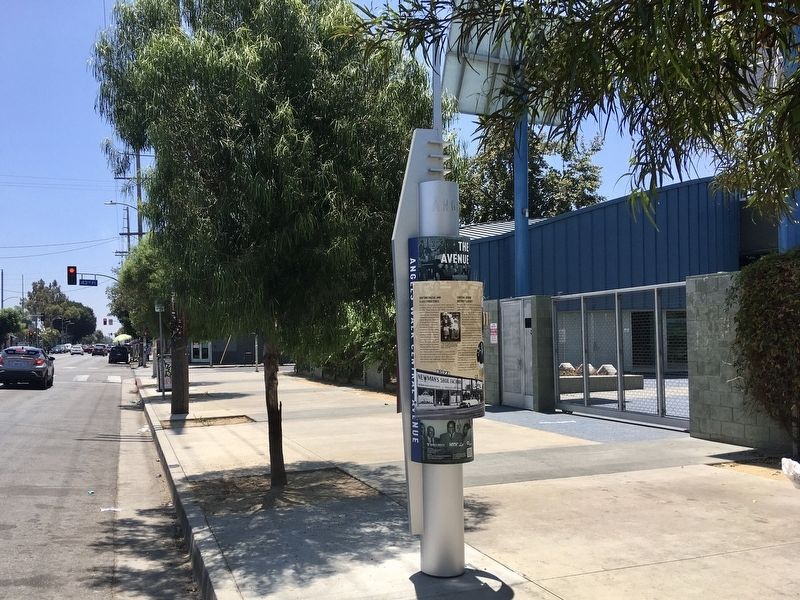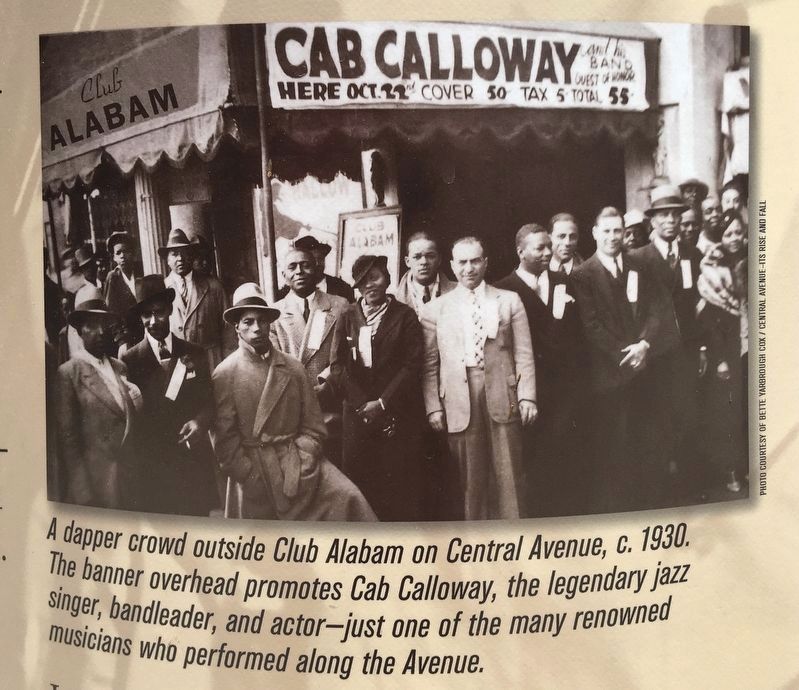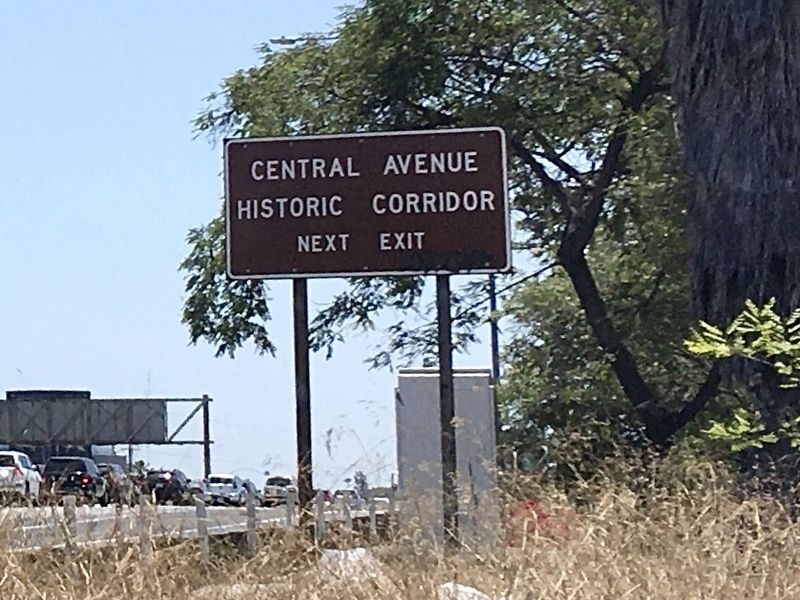South Los Angeles in Los Angeles County, California — The American West (Pacific Coastal)
Central Avenue Historic District
The Avenue
Shifting Racial and Class Structures
People of African ancestry were among the founding citizens of Los Angeles (Los Pobladores) in 1781. Beginning in the 1850s, successive waves of African Americans migrated west, forming an influential community that helped shape the character of the growing metropolis. For many newcomers, Southern California's temperate climate, striking natural surroundings, greater economic opportunities, and social freedoms provided a better quality of life than they had experienced in the places they left behind. That said, African American pioneers and other people of color had to constantly battle deeply rooted bigotry and shifting racial and class structures to negotiate their rights as citizens. Despite the challenges, African Americans actively participated in the city's development.
Central Avenue District’s Legacy
Between 1900 and 1930, the African American population in Los Angeles increased more than eighteenfold, from 2,131 to 38,894. Meanwhile, the city's general population exploded from 102,479 to nearly 1.2 million. During those years, whites made up the majority, and the numbers of ethnic Mexicans and Japanese equaled those of African Americans. The south-of-downtown community, for which Central Avenue served as the spine, flourished well into the 1950s. Its African American residents bought homes, raised families, established businesses, created social and faith institutions, and nurtured a rich cultural milieu with theaters, jazz clubs, dance halls, newspapers, as well as book and record stores. In a show of that progress, Frederick Madison Roberts, a Republican, was elected as the first man known to be of African American descent to serve in the California State Assembly, representing the multiethnic Central Avenue district from 1918 to 1934.
The district emerged as an important force in the national civil rights movement. African Americans effected change on many fronts — social, political, economic, religious, and cultural. Court cases and changes in public policies chipped away at discrimination in housing and employment. As the years passed, African Americans began to seek opportunities in neighborhoods farther west and south, and Central Avenue's influence ebbed.
Birthplace of a Thriving Jazz Scene
So many jazz clubs opened along Central Avenue from the 1920s to the 1940s that the California Eagle newspaper dubbed the stretch "Brown Broadway." Club Alabam, one of the area's most exclusive spots, was located next door to the lavish Dunbar Hotel and attracted A-list Hollywood stars. Live music radiated from dozens of clubs seven nights a week, including Club Congo, the Downbeat Club, the Last Word, Club Memo, and Ivies Chicken Shack.
In 1920, eight musicians representing an array of genres, and motivated by discrimination, formed the all-black Local 767 union. With about 1,000 members, it was the second-largest black union in the American Federation of Musicians (AFM). The group purchased a house at 1710 Central Avenue, which functioned as its office, clubhouse, and rehearsal space. Each Labor Day, the union would organize a popular parade along Central Avenue, in which the bands of Count Basie, Duke Ellington, and others played while standing on trucks or marching. Los Angeles musicians belonged to either the all-white Local 47 or Local 767 until the early 1950s, when Marl Young and others started pushing for the two unions to desegregate and unite. By the mid-1950s, the jukebox had stifled the need to hire live bands, and many middle-class African Americans were moving west to neighborhoods previously closed to them due to restrictive housing covenants. R&B (often played by whites) was overtaking jazz in popularity and the Avenue's Golden Era was coming to a close.
Erected 2020 by City of Los Angeles.
Topics. This historical marker is listed in these topic lists: African Americans • Arts, Letters, Music • Entertainment.
Location. 34° 0.316′ N, 118° 15.398′ W. Marker is in Los Angeles, California, in Los Angeles County. It is in South Los Angeles. Marker is on Central Avenue south of 43rd Street, on the right when traveling south. Touch for map. Marker is at or near this postal address: 4301 S Central Ave, Los Angeles CA 90011, United States of America. Touch for directions.
Other nearby markers. At least 8 other markers are within walking distance of this marker. The Los Angeles Sentinel (within shouting distance of this marker); Golden State Mutual (about 400 feet away, measured in a direct line); Dolphin’s of Hollywood (about 400 feet away); Apex / Club Alabam (about 600 feet away); Dunbar Hotel (about 600 feet away); The Downbeat Club (about 800 feet away); Vernon Branch Library (approx. 0.2 miles away); Black Panthers in L.A. (approx. ¼ mile away). Touch for a list and map of all markers in Los Angeles.
Also see . . . Angels Walk L.A. Self-guided walking tours of historic neighborhoods in Los Angeles. This marker is part of the Central Avenue walk. (Submitted on January 31, 2022.)
Credits. This page was last revised on June 23, 2023. It was originally submitted on January 31, 2022, by Craig Baker of Sylmar, California. This page has been viewed 606 times since then and 88 times this year. Photos: 1, 2, 3, 4, 5, 6. submitted on January 31, 2022, by Craig Baker of Sylmar, California.
